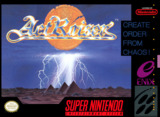A somewhat overlooked yet compelling classic.
In a nutshell, you play the part of a god who has been sleeping for a long time, and has finally returned to the land in order to restore order and prosperity to your people. The game takes place in three fundamental parts -- firstly, in your cloud-castle, you can rest and plan your next move, travel to different parts of the world, save the game, and decide which combat spell to take with you into battle. After a brief introduction in your castle from a cherub (which the game insists is an angel), you are sent down to combat the evil that has plagued your lands.
Transferring your godly essence into a statue of a sword-wielding warrior, you must navigate various worlds in this part of the game, slaying a variety of enemies and collecting power-ups (which are fairly mediocre, spanning only the most bare essentials such as extra lives and health, or bonus score), until you reach and defeat the boss at the end of the stage. While fairly enjoyable, these platform elements are standard at best, offering absolutely nothing beyond what you'd expect from a purely average platformer. The controls can seem a little unresponsive when trying to perform complex maneuvers (such as jumping, then swinging your sword in mid-air), and for the most part, all you'll really be doing is walking around, jumping and ducking on occasion, and smacking enemies with a sharpened piece of metal.
It should be noted at this point that in the European version of the game, you can choose to play "action mode", which simply involves the platformer elements of the game and nothing else. Should you choose this mode, this is more or less all you'll be doing throughout the entire game, and I'm sorry to say that it gets old, very quickly. Curiously, this mode is only available in the American and Japanese releases of the game through using a cheat code, and even then, only when the game has been beaten once already.
Thankfully, once you beat the first boss, the game opens up and switches to "sim mode". In this mode, you take control of the cherub and must fend off attacks from monsters in a top-down view, while showing your people where to expand their town and casting beneficial spells such as lightning (to clear obstacles), sunlight (to dry up snow), and so on. It's fairly straightforward on the surface, and there's no "wrong" decisions -- eventually, no matter which way you go about it, the town will fill every possible space and the population will reach its maximum. Nontheless, there's enough freedom to keep this part interesting.
After a short period of time, your people will become experienced enough at hunting to be able to seal the monster lairs (which, until sealed, continually spawn flying monsters), as well as gaining other achievements such as the ability to build bridges, or grow wheat. Your loyal citizens will also offer any magical items they find -- such as scrolls to increase your magic power, or new spells -- as well as humbly request your assistance with problems they can't deal with alone. It feels a lot like a much more primitive version of Black & White, though for the most part, the villagers are happy to take care of themselves.
As the population reaches certain levels, you increase in power and have more strength to fend off the monsters in action mode, another incentive to stick with your people and make sure they're living as well as they can be. After a while, though, they'll usually say that they don't need any more help, they're very grateful but you can go elsewhere now. At this point, you can start venturing off into other areas, starting new towns, completing new quests, and fending off ever-more-powerful bad guys as you seek to restore order to your corrupted lands. A nice touch is that you can sometimes take an item that has been developed in one village -- such as bridges, or wheat -- and offer it to another, to increase their growth and maximum population level.
While the platform elements are fairly basic and the sim mode is hardly going to wrack your brain, the overall package combines into a well-balanced gameplay experience which gives a solid action experience followed by a more relaxed (yet still frantic at times) breather, then back to the action to fight yet more nameless foes. Overall, this is a highly enjoyable game which provides many hours of gameplay and a fair amount of replay value.

